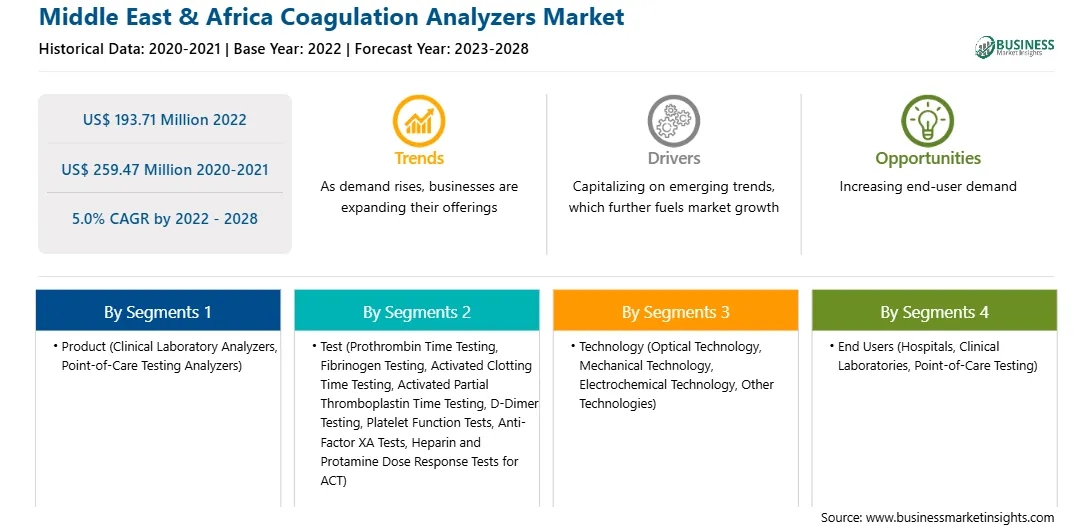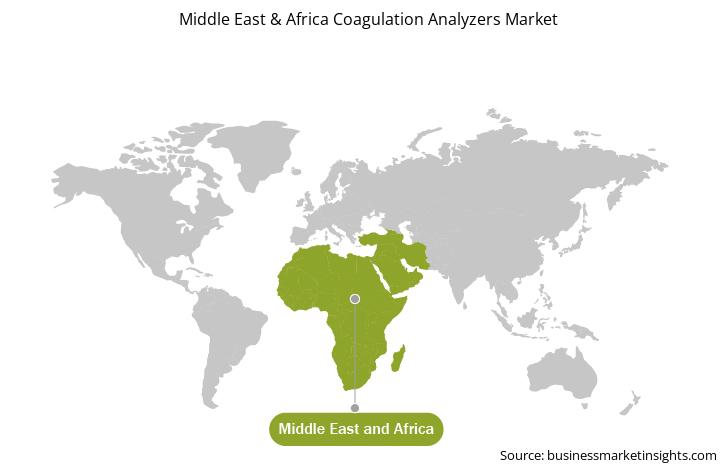Development of Point-of-Care (POC) Coagulation Analyzers is Driving the Middle East & Africa Coagulation Analyzers Market
A rapid, reliable assessment of hemostasis is essential for patients with trauma or other bleeding problems. Due to the requirements of sample preparation and the analytical process, routine coagulation assays cannot visualize the process of clot formation, and their results are obtained only after 30-90 minutes. Point-of-care (POC) devices such as viscoelastic coagulation tests, platelet function tests, blood gas analysis, and other coagulometers are available for assessment of hemostasis. A POC measurement tool can be used both inside and outside the hospital as a decision-making and management tool. When time is paramount, POC analyzers provide immediate, actionable results in emergency rooms, coronary care units, surgery, and procedure suites. In addition to outpatient clinics and physicians' offices, these devices can assist with patient management in pharmacies, care centers, and patients' homes. POC coagulation analyzers offer timely results without compromising diagnostic quality control provided by central labs. In POC testing, it is important to provide fast results, along with accuracy and quality assurance.
In 2021, Siemens Healthineers launched fully automated CN-3000 and CN-6000 systems, which are mid- and high-volume handheld POC coagulation testing devices. Siemens Healthineers' Xprecia Stride Coagulation Analyser was cleared by the FDA as a POC coagulation analyzers device. The device has demonstrated PT/INR (prothrombin time/international normalized ratio) testing performance equivalence to Roche CoaguChek XS.
Thus, the growing development of POC coagulation analyzer is likely to propel the Middle East & Africa coagulation analyzers market growth during the forecast period.
Middle East & Africa Coagulation Analyzers Market Overview
The Middle East & Africa consists of three major countries, namely the UAE, Saudi Arabia, and South Africa. The market is expected to have significant growth opportunities owing to the rising development in the medical facilities, increasing prevalence of blood disorders, and rise in incidences of atrial fibrillation and other cardiovascular diseases.
Saudi Arabia is among the well-established country in the Middle East region. It is accounted for as the richest economies and is developing in terms of the healthcare sector rapidly. However, the country is majorly dependent on imports for medical device products. The rising incidences of chronic and acute diseases such as cardiovascular disorders have led to increasing demand for coagulation analyzers in the country. Coronary heart disease constitutes one of the main health problems in Saudi Arabia, constituting the third most common cause of hospital-based mortality, second to accident and senility. According to Archives of Pharmacy Practice, the prevalence of coronary heart disease is at 6%, stipulating a high burden of disease and associated risk factors. Similarly, the increasing prevalence of cardiovascular diseases in the UAE will likely to increase the demand coagulation analyzers. According to a study conducted by Cleveland Clinic Abu Dhabi, more than half of the residents in UAE have been affected by heart disease during their lifespan. Cardiovascular disease is the prime cause of death in the UAE, with symptoms in patients often occurring a decade earlier than their counterparts in other developed nations. According to an article published by PLOS ONE, CVD contributes to 40% of all deaths. Its incidence is increasing in young adults mainly because of an increase in the burden of its known risk factors such as abdominal obesity (71.5%), dyslipidemia (74.0%), hypertension (43.0%), and diabetes (32.4%).
Also, rising prevalence of genetic blood disorder in the region is likely to increase the demand for coagulation analyzer in the market. The prevalence of genetic blood disorders (sickle cell anemia and thalassemia) varies among the different regions of the Kingdom of Saudi Arabia. The highest rates are recorded in the eastern and southern regions, while the rates are low in the central and northern regions of the Kingdom. Additionally, as per the Dubai Health Authority, in 2019, there were about 2,000 people with thalassaemia in the UAE. Further, the government-run Thalassaemia Centre in Dubai had around 850 patients and of which 450 were critical ones who needed regular blood transfusions. Additionally, as per the World Federation of Hemophilia, in South Africa, in 2019, ~24.6/100,000 males had hemophilia A and 5.0/100,000 males had hemophilia B. also, the prevalence of Von Willebrand Disease (VWD) with bleeding symptoms to primary care physicians appears to be approximately 1 in 1,000.
South Africa faces a chronic cardiovascular disease burden, including high rates of hypertension and cardiac arrest. South Africa is experiencing an increasing burden of cardiovascular diseases, including coronary heart disease (CHD) and stroke. According to WHO, it is estimated that the rate of premature death due to CVD amongst South African adults is projected to increase by 41% between 2000 and 2030. Moreover, in South Africa stroke is a leading cause of death and disability. An increase in the burden of stroke is expected as the population is experiencing a rapid epidemiological transition with increased exposure to and development of stroke risk factors, together with the aging of the population. Healthcare facilities in South Africa are developing and adopting the latest technologies to offer better treatments and diagnoses.
Although the region remains highly exposed to political uncertainty, medical device exports will gain from accelerated economic growth in Sub-Saharan Africa, which will be aided by increased commodity prices and improved investor enthusiasm. In Sub-Saharan Africa, South Africa is the key business center for the medical device industry. A large percentage of medical device and lab equipment exports go to other African countries, with 12 African countries among the top 20 export destinations. Thus, owing to the factors mentioned above, the country is expected to provide an opportunistic scenario for coagulation analyzers market growth in South Africa.
In addition, development in technology, healthcare infrastructure has increased the use of online distribution channels for buying diagnostic devices. The other factors, such as increasing incidences of peripheral artery disease, and rising healthcare expenditure, are likely to lead to the growth of the market during the forecast period. In addition, the growing investment in the healthcare industry is expected to enhance market growth significantly.
Strategic insights for the Middle East & Africa Coagulation Analyzers provides data-driven analysis of the industry landscape, including current trends, key players, and regional nuances. These insights offer actionable recommendations, enabling readers to differentiate themselves from competitors by identifying untapped segments or developing unique value propositions. Leveraging data analytics, these insights help industry players anticipate the market shifts, whether investors, manufacturers, or other stakeholders. A future-oriented perspective is essential, helping stakeholders anticipate market shifts and position themselves for long-term success in this dynamic region. Ultimately, effective strategic insights empower readers to make informed decisions that drive profitability and achieve their business objectives within the market. The geographic scope of the Middle East & Africa Coagulation Analyzers refers to the specific areas in which a business operates and competes. Understanding local distinctions, such as diverse consumer preferences (e.g., demand for specific plug types or battery backup durations), varying economic conditions, and regulatory environments, is crucial for tailoring strategies to specific markets. Businesses can expand their reach by identifying underserved areas or adapting their offerings to meet local demands. A clear market focus allows for more effective resource allocation, targeted marketing campaigns, and better positioning against local competitors, ultimately driving growth in those targeted areas.
Middle East & Africa Coagulation Analyzers Strategic Insights

Middle East & Africa Coagulation Analyzers Report Scope
Report Attribute
Details
Market size in 2022
US$ 193.71 Million
Market Size by 2028
US$ 259.47 Million
Global CAGR (2022 - 2028)
5.0%
Historical Data
2020-2021
Forecast period
2023-2028
Segments Covered
By Product
By Test
By Technology
By End Users
Regions and Countries Covered
Middle East and Africa
Market leaders and key company profiles
Middle East & Africa Coagulation Analyzers Regional Insights

Middle East & Africa Coagulation Analyzers Market Segmentation
The Middle East & Africa coagulation analyzers market is segmented into product, test, technology, end users, and country.
Based on product, the Middle East & Africa coagulation analyzers market is segmented into clinical laboratory analyzers and point-of-care testing analyzers. The clinical laboratory analyzers segment held the larger Middle East & Africa coagulation analyzers market share in 2022.
Based on test, the Middle East & Africa coagulation analyzers market is segmented into prothrombin time testing, fibrinogen testing, activated clotting time testing, activated partial thromboplastin time testing, d-dimer testing, platelet function tests, anti-factor xa tests, heparin and protamine dose response tests for act, and others. The prothrombin time testing segment held the largest Middle East & Africa coagulation analyzers market share in 2022.
Based on technology, the Middle East & Africa coagulation analyzers market is segmented into optical technology, mechanical technology, electrochemical technology, and other technologies. The optical technology segment held the largest Middle East & Africa coagulation analyzers market share in 2022.
Based on end users, the Middle East & Africa coagulation analyzers market is segmented into hospitals, clinical laboratories, point-of-care testing, and others. The clinical laboratories segment held the largest Middle East & Africa coagulation analyzers market share in 2022.
Based on country, the Middle East & Africa coagulation analyzers market is segmented into the UAE, Saudi Arabia, South Africa, and the Rest of the Middle East & Africa. The Saudi Arabia dominated the Middle East & Africa coagulation analyzers market share in 2022.
Abbott Laboratories; Danaher Corp; F. Hoffmann-La Roche Ltd; Horiba Ltd.; Nihon Kohden Corp; Shenzhen Mindray Bio-Medical Electronics Co., Ltd.; Siemens Healthcare GmbH; Sysmex Corporation; and Thermo Fisher Scientific Inc are the leading companies operating in the Middle East & Africa coagulation analyzers market.
The Middle East & Africa Coagulation Analyzers Market is valued at US$ 193.71 Million in 2022, it is projected to reach US$ 259.47 Million by 2028.
As per our report Middle East & Africa Coagulation Analyzers Market, the market size is valued at US$ 193.71 Million in 2022, projecting it to reach US$ 259.47 Million by 2028. This translates to a CAGR of approximately 5.0% during the forecast period.
The Middle East & Africa Coagulation Analyzers Market report typically cover these key segments-
The historic period, base year, and forecast period can vary slightly depending on the specific market research report. However, for the Middle East & Africa Coagulation Analyzers Market report:
The Middle East & Africa Coagulation Analyzers Market is populated by several key players, each contributing to its growth and innovation. Some of the major players include:
The Middle East & Africa Coagulation Analyzers Market report is valuable for diverse stakeholders, including:
Essentially, anyone involved in or considering involvement in the Middle East & Africa Coagulation Analyzers Market value chain can benefit from the information contained in a comprehensive market report.